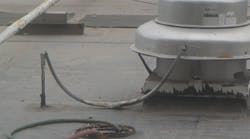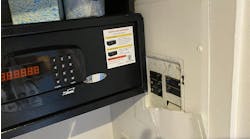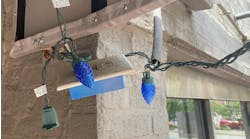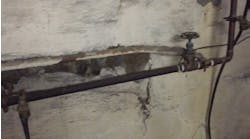As usual, never consider the following commentary associated with these photos as a formal interpretation of the National Electrical Code (NEC). Without criticizing anyone or any product, the following scenarios present us with serious safety questions.
BROKEN LIQUIDTIGHT FLEXIBLE METAL CONDUIT
In addition to supplying ventilation equipment, this piece of LTFMC was also used as a perch by a few pigeons that frequent this hotel rooftop everyday. Lack of proper support and the weight of the pigeons and their droppings probably caused these connections to break and show signs of lost electrical continuity.
SCREWED-UP CONNECTION
David Lewis, a service technician and assistant manager for Haymaker Electric, found this keyless lampholder in the electrical equipment room of an 18-story office building in Birmingham, Ala.
The lampholder isn't secured to the outlet box because the installer didn't use the supporting screws. As a result, it's hanging from the switch leg and the grounded circuit conductor. The wire connectors show where there were other spliced conductors that have been cut away. However, the use of a long screw at the termination is the real issue here because it's being misused. The person responsible for this installation clearly isn't qualified as defined by Article 100.
MULTIPLE CONNECTIONS
Blane Quilhot, a maintenance engineer, and his father-in-law Philip Sattler, a retired master electrician, both of Quincy, Mich., discovered this 150A disconnect while tracing the wiring for a blower control. It was connected to several lugs not recognized for use with more than one conductor. This is a common violation of Sec. 110.14(A), which requires conductors to be connected to terminal parts without damaging the conductors.
The connections must be made by means of pressure connectors (including set-screw type), solder lugs, or splices to flexible leads. This installation is in violation of the requirement that any terminal used for more than one conductor and any terminal used to connect aluminum must be so identified.
UNRECOGNIZED UNDERFLOOR WIRING
Steve Sullivan, a project engineer, discovered these feeders that run in the open from raceways bonded together in the underfloor space of an information technology equipment room. The open feeder conductors are neither enclosed in a proper raceway nor are they installed according to a recognized practice. The installer should have complied with 654.2 and the rule in 645.5(D)(2) for areas under raised floors, which requires field-wired equipment to be installed in rigid metal conduit, rigid nonmetallic conduit, intermediate metal conduit, electrical metallic tubing, or electrical nonmetallic tubing. It must also be installed in metal wireway, nonmetallic wireway, surface metal raceway with metal cover, nonmetallic surface raceway, flexible metal conduit, liquidtight flexible metal conduit, liquidtight flexible nonmetallic conduit, Type MI cable, Type MC cable, or Type AC cable. These supply conductors must also be installed in accordance with the requirements of 300.11.



